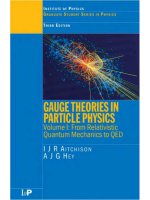Quantum systems in chemistry and physics vol 1 basic problems and model systems
Bạn đang xem bản rút gọn của tài liệu. Xem và tải ngay bản đầy đủ của tài liệu tại đây (2.98 MB, 435 trang )
QUANTUM SYSTEMS IN CHEMISTRY AND PHYSICS
Basic Problems and Model Systems
Progress in Theoretical Chemistry and Physics
Volume 2
Honorary Editors:
William N. Lipscomb (Harvard, MA, USA)
Ilya Prigogine (Brussels, Belgium)
ExecutiveEditors :
Jean Maruani (Paris, France)
Stephen Wilson (Oxon, UK)
Advisory Editors:
Hans Agren (Stockholm, Sweden)
David Avnir (Jerusalem, Israel)
Jerzy Cioslowski (Tallahassee, FL, USA)
Raymond Daudel (Paris, France)
K.U. Gross (Würzburg, Germany)
W.F. van Gunsteren (Zỹrich, Switzerland)
Kimihiko Hirao (Tokyo, Japan)
Ivan Hubaỗ (Bratislava, Slovakia)
Melvyn P. Levy (New Orleans, LA, USA)
Gulzari L. Malli (Burnaby, Canada)
Roy McWeeny (Pisa, Italy)
Paul G. Mezey (Saskatoon, Canada)
M.A.C. Nascimento (Rio, Brazil)
Jacek Rychlewski (Poznan, Poland)
Steven D. Schwartz (New York, NY, USA)
Yves G. Smeyers (Madrid, Spain)
Sandor Suhai (Heidelberg, Germany)
Orlando Tapia (Uppsala, Sweden)
Peter R. Taylor (San Diego, CA, USA)
R. Guy Woolley (Nottingham, UK)
Quantum Systems in Chemistry
and Physics
Volume 1
Basic Problems and Model Systems
Granada, Spain, 1998
Edited by
Alfonso Hernández-Laguna
Estación Experimental del Zaidín (C.S.I.C.), Granada, Spain
Jean Maruani
Laboratoire de Chimie Physique (C.N.R.S.), Paris, France
Roy McWeeny
Universita di Pisa, Pisa, Italy
and
Stephen Wilson
Rutherford Appleton Laboratory, Oxfordshire, United Kingdom
KLUWER ACADEMIC PUBLISHERS
NEW YORK / BOSTON / DORDRECHT / LONDON / MOSCOW
eBook ISBN:
Print ISBN:
0-306-46941-3
0-792-35969-0
©2002 Kluwer Academic Publishers
New York, Boston, Dordrecht, London, Moscow
Print ©2000 Kluwer Academic Publishers
London
All rights reserved
No part of this eBook may be reproduced or transmitted in any form or by any means, electronic,
mechanical, recording, or otherwise, without written consent from the Publisher
Created in the United States of America
Visit Kluwer Online at:
and Kluwer's eBookstore at:
Progress in Theoretical Chemistry and Physics
A series reporting advances in theoretical molecular and material
sciences, including theoretical, mathematical and computational
chemistry, physical chemistry and chemical physics
Aim and Scope
Science progresses by a symbiotic interaction between theory and experiment: theory is
used to interpret experimental results and may suggest new experiments; experiment
helps to test theoretical predictions and may lead to improved theories. Theoretical
Chemistry (including Physical Chemistry and Chemical Physics) provides the conceptual and technical background and apparatus for the rationalisation of phenomena in the
chemical sciences. It is, therefore, a wide ranging subject, reflecting the diversity of
molecular and related species and processes arising in chemical systems. The book
series Progress in Theoretical Chemistry and Physics aims to report advances in
methods and applications in this extended domain. It will comprise monographs as well
as collections of papers on particular themes, which may arise from proceedings of
symposia or invited papers on specific topics as well as initiatives from authors or
translations.
The basic theories of physics – classical mechanics and electromagnetism, relativity
theory, quantum mechanics, statistical mechanics, quantum electrodynamics – support
the theoretical apparatus which is used in molecular sciences. Quantum mechanics
plays a particular role in theoretical chemistry, providing the basis for the valence
theories which allow to interpret the structure of molecules and for the spectroscopic
models employed in the determination of structural information from spectral patterns.
Indeed, Quantum Chemistry often appears synonymous with Theoretical Chemistry: it
will, therefore, constitute a major part of this book series. However, the scope of the
series will also include other areas of theoretical chemistry, such as mathematical
chemistry (which involves the use of algebra and topology in the analysis of molecular
structures and reactions); molecular mechanics, molecular dynamics and chemical
thermodynamics, which play an important role in rationalizing the geometric and
electronic structures of molecular assemblies and polymers, clusters and crystals;
surface, interface, solvent and solid-state effects; excited-state dynamics, reactive
collisions, and chemical reactions.
Recent decades have seen the emergence of a novel approach to scientific research,
based on the exploitation of fast electronic digital computers. Computation provides a
method of investigation which transcends the traditional division between theory and
experiment. Computer-assisted simulation and design may afford a solution to complex
problems which would otherwise be intractable to theoretical analysis, and may also
provide a viable alternative to difficult or costly laboratory experiments. Though
stemming from Theoretical Chemistry, Computational Chemistry is a field of research
v
Progress in Theoretical Chemistry and Physics
in its own right, which can help to test theoretical predictions and may also suggest
improved theories.
The field of theoretical molecular sciences ranges from fundamental physical
questions relevant to the molecular concept, through the statics and dynamics of
isolated molecules, aggregates and materials, molecular properties and interactions, and
the role of molecules in the biological sciences. Therefore, it involves the physical basis
for geometric and electronic structure, states of aggregation, physical and chemical
transformations, thermodynamic and kinetic properties, as well as unusual properties
such as extreme flexibility or strong relativistic or quantum-field effects, extreme
conditions such as intense radiation fields or interaction with the continuum, and the
specificity of biochemical reactions.
Theoretical chemistry has an applied branch – a part of molecular engineering,
which involves the investigation of structure–property relationships aiming at the
design, synthesis and application of molecules and materials endowed with specific
functions, now in demand in such areas as molecular electronics, drug design or genetic
engineering. Relevant properties include conductivity (normal, semi- and supra-),
magnetism (ferro- or ferri-), optoelectronic effects (involving nonlinear response),
photochromism and photoreactivity, radiation and thermal resistance, molecular recognition and information processing, and biological and pharmaceutical activities, as well
as properties favouring self-assembling mechanisms and combination properties needed
in multifunctional systems.
Progress in Theoretical Chemistry and Physics is made at different rates in these
various research fields. The aim of this book series is to provide timely and in-depth
coverage of selected topics and broad-ranging yet detailed analysis of contemporary
theories and their applications. The series will be of primary interest to those whose
research is directly concerned with the development and application of theoretical
approaches in the chemical sciences. It will provide up-to-date reports on theoretical
methods for the chemist, thermodynamician or spectroscopist, the atomic, molecular or
cluster physicist, and the biochemist or molecular biologist who wish to employ
techniques developed in theoretical, mathematical or computational chemistry in their
research programmes. It is also intended to provide the graduate student with a readily
accessible documentation on various branches of theoretical chemistry, physical chemistry and chemical physics.
vi
Contents
Preface
xi
Part I. Density Matrices and Density Functionals
Three-body correlation effects in third-order reduced density matrices
C. Valdemoro, L.M. Tel and E. Pérez-Romero
3
Part II. Electron Correlation Effects
Many-particle Sturmians applied to molecules
J. Avery and S. Sauer
19
Treatment of electron correlation in localized representation
C. Kozmutza, E. Kapuy and L. Udvardi
41
Comparing (SC)2CAS-SDCI and externally corrected CCSD methods
G. Peris, J.-P. Malrieu and J. Planelles
73
The size-consistent self-consistent SDCI method for excited states and
ionization potentials
J. Pitarch-Ruiz, J. Sánchez-Marín, I. Nebot-Gil, N. Ben Amor and
D. Maynau
87
Ab initio summation over states/SCI for static and dynamic first
hyperpolarizabilities of small molecules
M. Spassova, V.Monev, I. Kanev, B. Champagne, D.H. Mosley and
J.-M. André
101
Correlation energies for diatomic molecules: a re-evaluation of the
empirical estimates for the N2, CO, BF and NO+ systems
H.M. Quiney, D. Moncrieff and S. Wilson
127
Influence of electron correlation on the electronic structure of
superconducting Y-ceramics
I.G. Kaplan, J. Hernández-Cóbos and J. Soullard
143
vii
Contents
Part III. Relativistic Formulations
Energies and other properties of heavy atoms and molecules
U. Kaldor and E. Eliav
161
Variational principle in the Dirac theory: theorems, examples and counterexamples
J. Karwowski, G. Pestka and M. Stanke
177
Perspectives in relativistic Thomas-Fermi calculations for atomic sytems
I. Porras and A. Moya
195
Expectation values for ground-state atoms from a modified Thomas-FermiDirac approach
A. Moya and I. Porras
215
Correlated effective single-particle theory: relativistic optimized-potential
method
E. Engel and A. Facco-Bonetti
227
Ab-initio ZORA calculations
S. Faas, JG. Snijders and J.H. van Lenthe
251
Relativistic oscillator strengths for excited-state transitions in halogen
atoms. Regularities
C. Lavín, A.M. Velasco and I. Martín
263
Extension of the relativistic quantum defect orbital method to the treatment
of many-valence electron atoms. Atomic transitions in Ar II
I. Martín, A.M. Velasco and C. Lavín
273
Part IV. Valence Theory
Hyperspherical harmonics as atomic and molecular orbitals in momentum
space
V. Aquilanti, S. Cavalli, C. Coletti, D. Di Domenico and G. Grossi
291
An overview of the CASVB approach to modern valence bond calculations
T. Thorsteinsson and D.L. Cooper
303
Modern valence-bond description of the mechanisms of six-electron
pericyclic reactions
P.B. Karadakov, D.L. Cooper, T. Thorsteinsson and J. Gerratt
327
viii
Contents
A topological study of electron transfer and three-electron bond
X. Krokidis and A. Sevin
345
BSSE-free MCSCF method for strong hydrogen bonds: investigation of
H2O-HCl and NH3-HCl complexes
A. Famulari, M. Sironi and M. Raimondi
361
Part V. Nuclear Motion
Non-adiabatic molecular Hamiltonian. Canonical transformation coupling
electronic and vibrational motions
I. Hubac, P. Babinec, M. Polásek, J. Urban, P. Mach, J. Másik and
J. Leszczyn' ski
383
The effect of pseudopotential on the torsional energy levels of hydrogen
peroxide and deuterium peroxide
M.L. Senent and Y.G. Smeyers
401
Contents of Volume 2
415
Combined Index to Volumes 1 and 2
419
^
ix
^
^
^
This page intentionally left blank.
Preface
These two volumes collect forty-four selected papers from the scientific contributions
presented at the Third European Workshop on Quantum Systems in Chemistry and
Physics, held in Granada (Spain), April 19–22, 1998. Ninety-nine scientists from
Bulgaria, Columbia, Cuba, Denmark, Finland, France, Germany, Hungary, Israel, Italy,
Mexico, Netherlands, Norway, Poland, Russia, Slovakia, Spain, Sweden, United Kingdom, Uruguay and Venezuela attended the workshop, discussing the state of the art,
new trends, and future evolution of the methods and applications.
The workshop took place at the ‘Los Alixares’ Hotel, where 45 lectures were given
by prominent members of the scientific community; in addition, 49 posters were
presented in two very animated sessions. The success of this workshop is due, without
doubt, to the excellent tradition initiated at the previous workshops, organised by Prof.
R. McWeeny in San Miniato, Pisa (Italy), 1996, and by Prof. S. Wilson in Oxford
(United Kingdom), 1997. These workshops create occasions for meetings and discussions on the current state of the art, emerging methods and applications and new trends
in this area of science. The three meetings were sponsored and partially supported by
the European Union (EU) in the frame of the Cooperation in Science and Technology
(COST) chemistry actions.
Quantum Systems in Chemistry and Physics is a broad area of science in which
scientists of different extractions and aims jointly place special emphasis on quantum
theory. Several topics were presented in the sessions of the symposia, namely: 1:
Density matrices and density functionals; 2: Electron correlation effects (many-body
methods and configuration interactions); 3: Relativistic formulations; 4: Valence theory
(chemical bonds and bond breaking); 5: Nuclear motion (vibronic effects and flexible
molecules); 6: Response theory (properties and spectra; atoms and molecules in strong
electric and magnetic fields); 7: Condensed matter (crystals, clusters, surfaces and
interfaces); 8: Reactive collisions and chemical reactions, and 9: Computational
chemistry and physics.
The first topic has an important role in the interpretation and calculation of atomic
and molecular structures and properties. It is needless to stress the importance of
electronic correlation effects, a central topic of research in quantum chemistry. The
relativistic formulations are of great importance not only from a formal viewpoint, but
also for the increasing number of studies on atoms with high Z values in molecules and
materials. Valence theory deserves special attention since it improves the electronic
description of molecular systems and reactions with the point of view used by most
laboratory chemists. Nuclear motion constitutes a broad research field of great importance to account for the internal molecular dynamics and spectroscopic properties.
Also very broad, complex and of great importance in physics and chemistry is the
sixth topic, where electric and magnetic fields interact with matter. Condensed matter is
a field where theoretical studies are performed from few-atom clusters to crystals,
materials and interfaces; the theory becomes more and more complex and new scientific
ideas and models are sought. The theory with which to study chemical reactions and
xi
Preface
collisions is the cornerstone of chemistry; traditional concepts such as potential-energy
surfaces or transition complexes appear to become insufficient.
The last topic is an innovation of this third workshop. To start with, the new EU
COST-Chemistry D-9 action is devoted to ‘Advanced Computational Chemistry of
Increasingly Complex Systems’, aiming at enlarging the scope, theory, techniques and
algorithms of computational chemistry to perform more realistic modelling of chemical
systems; in addition, computational chemistry has become an advanced field of research
very relevant to science and technology in chemistry, biology, pharmacology, materials
science and related fields. We recall with pleasure the 1998 chemistry Nobel prize
awarded to two scientists for their important contributions to computational chemistry.
Finally, we should mention the increasing power of modern computers to assist the
development of more powerful theories and algorithms and more realistic modelling for
complex systems. Nowadays, computational chemistry is finally close to that level
envisioned by R. S. Mulliken who wrote, at the conclusion of his Nobel prize lecture:
‘. . . chemists will go to computer centres more frequently than to laboratories’.
We acknowledge the support from the following institutions: COST-Chemistry D-9,
‘Dirección General de Ensanza Superior e Investigación Científica’, Spanish National
Research Council (C.S.I.C.), Andalucian Government, University of Granada, City Hall
of Granada and ‘Caja Rural de Granada’. The kind attentions of the staff of Porcel’s
Hotels are also acknowledged. Finally, it is a pleasure to thank the work and dedication
of the other members of the local organising team (Prof. D. Portal-Olea, Dr. C.I. SainzDiaz, Dr. J.A. Dobado, Dr. Z. Cruz-Rodríguez, Dr. H. Martínez-García, Lda. L.
Alfonso-Méndez and Lda. M. Daza) and, last but not least, the interest and help of Dr.
Gérard Rivière at the European Commission.
A. Hernández-Laguna and J. Molina-Molina
Granada, 1999
xii
Part I
Density Matrices and
Density Functionals
This page intentionally left blank.
Three-Body Correlation Effects in Third-Order Reduced
Density Matrices
C. Valdemoroa, L.M. Telb and E. Pérez-Romerob
aInstituto
de Matemáticas y Física Fundamental, Consejo Superior de Investigaciones
Científicas, Serrano 123, Madrid 28006, Spain
bDpto. de Química Física, Universidad de Salamanca, Salamanca 37008, Spain
Abstract
A description of the different terms contributing to the correlation effects in the third order
reduced density matrix taking as reference the Hartree Fock results is given here. An
analysis of the approximations of these terms as functions of the lower order reduced
density matrices is carried out for the linear BeH2 molecule. This study shows the
importance of the role played by the homo’s and lumo’s of the symmetry-shells in the
correlation effect. As a result, a new way for improving the third order reduced density
matrix, correcting the error of the basic approximation, is also proposed here.
1. Introduction
By integrating the Schrödinger Equation, Nakatsuji [1] and Cohen and Frishberg [2]
obtained in 1976 a two electron integro-differential equation, which they named density
equation. An equivalent matrix equation was reported in 1985 by Valdemoro [3]; and,
since it had been generated by application of a contracting mapping acting on the
matrix representation in the N-electron space of the Schrödinger equation, it was called
Contracted Schrödinger Equation (2-CSE ). This equation is undetermined [4] since its
solution depends not only on the second order Reduced Density Matrix (2-RDM ) but
also on the 3-RDM and 4-RDM. The possibility of building high order RDM’s as
function of the lower order ones – construction procedure – with a satisfactory degree
of approximation [5–7] opened the way to an iterative solution of the 2-CSE [8–14].
This promising approach relies on the optimization of the construction procedure and
therefore this question is dealt with here. Thus, the aim of this paper is to report our
latest results in this line of research focusing our attention on the manner in which the
electron correlation is taken into account in the construction procedure for the ααβ
block of the 3-RDM. In order to have an overall view of the previous work, we dedicate
the following section to the presentation of our notation and of a summary of the main
approaches to the construction procedure. Then (section three) the analysis of the
correlation matrices obtained for the ground state of the linear BeH2 molecule is
reported. In section four, after commenting an approximation proposed by Nakatsuji
and Yasuda [10,11] for estimating the three body correlation effects, an improving
modification is proposed. Finally, some concluding remarks are given in this same
section.
A. Hernández-Laguna et al. (eds. ), Quantum Systems in Chemistry and Physics, Vol. 1: Basic Problems and
Model Systems, 3–16.
© 2000 Kluwer Academic Publishers. Printed in Great Britain.
C. Valdemoro, L.M. Tel and E. Pérez-Romero
2.
General Background
2.1. Definitions
In what follows the number N of electrons of the system under study is a fixed number,
and the dimension of the finite Hilbert subspace spanned by the orthonormal basis of
spin-orbitals is 2K.
In our formalism, the 2-RDM is:
(1)
Similarly, the 2-order Holes Reduced Density Matrix (2-HRDM ) is:
(2)
The convention followed here is that the row/column indices of the RDM’s coincide
respectively with the creator/annihilator labels. The form of all kinds of higher order
RDM ’s can be inferred by extension of the definitions given above.
If an ordering is imposed on the indices, i.e. i1 < i2 < . . . and j1 < j2 < . . ., the
dimension of the matrices is reduced and the 2!, 3!, . . . respective factors are omitted.
Herafter we will refer to these two-, three-electron basis as ordered basis. Note that – in
an ordered basis – only one of the many inter-related elements is considered.
The first order transition RDM’s (1-TRDM ) also play an important role in this theory.
They are of the form
In general L and L' are N-electron orthonormal correlated states.
2.2.
Construction Procedures
The different approaches proposed in the literature for constructing the high order
RDM ’s as function of the lower order ones are summarized here, although some of their
features will be later considered in more detail.
The expectation values of the anticommutator/commutator of p-electron operators
lead to expressions of the type [5]
(3)
By identifying the holes part of the l.h.s. of this relation with the holes part of the
r.h.s. and similarly for the electrons, Valdemoro, Colmenero and Pérez del Valle [5–7]
built up a p-RDM in terms of the lower order RDM’s. This construction procedure will
be referred to in what follows as VCP and denoted in the formulae as D. Since the value
of the norm of the VCP matrix was very close – but not exactly equal – to ( Np ), different
procedures of renormalization were proposed [8,9,12]. This step should not be under^
4
Three-Body Correlation Effects in Third-Order Reduced Density Matrices
estimated, since the accuracy of the approximation is very sensitive to it. In fact, it is a
way of partially correcting the error of the approximation which is defined as
(4)
For the 3-RDM, which will center our attention in this paper, the VCP generates 15
terms which, as Mazziotti pointed out [13,14], may be expressed in a compact form as
(5)
Thus the exact 3-RDM may be written as:
(6)
Nakatsuji and Yasuda [10,11], on the basis of the asymptotic properties of the Green
functions and found an analogy between the VCP algorithm and the perturbative
expansion of these functions, and gave a diagramatic expression totally equivalent to
(6). The VCP, the Nakatsuji and Yasuda (hereafter refered to as NY) and Mazziotti’s
approaches differ in two kinds of ways. The first difference lies in the arguments leading
to (5) used by these authors. Thus, VCP exploits the symmetry between holes and
particles, NY conjectures that an RDM may be developed by a perturbative expansion
by analogy to the Green’s function one; and, more recently – Mazziotti [13,14] – while
keeping the essence of the many-body diagramatic expansions uses a generating
function instead of exploiting the asymptotic properties of the Green functions.
The other difference refers to the way in which the different groups approximate 3∆.
Thus, while VCP focus the attention on a renormalization of the approximated 3-RDM
which uses the complementary holes matrix, NY again inspire their procedure on the
assumption of an analogy with the Dyson equation. Finally, Mazziotti uses a selfconsistent algorithm which may be sumarized as: The 4-RDM is calculated by means
of an algorithm which coincides with the one proposed by NY, expressed in a compact
form as:
(7)
then this 4-RDM is contracted to obtain a new 3-RDM which is used for building a new
and this procedure is repeated until consistency.
The problem lies therefore on the interpretation and on how to estimate the error 3∆.
Although the base of all these approaches is rigorous, there are steps in all of them
which can only claim to be reasonable hypotheses. On the other hand, an analytical
decomposition, that may be applied to any high order RDM and which obviously
generates another construction procedure has been reported by Valdemoro, de LaraCastells, Pérez-Romero and Tel [12]. This procedure will be refered to here as VLPT.
Since the VLPT is formally exact, instead of looking for the best construction
procedure for high order RDM’s, the problem is reformulated as how to estimate the
pure two-, three-, four-body correlation terms in the VLPT or, equivalently, the 2∆, 3∆,
4∆ whose expressions we now know and which in general are closely related but are not
respectively identical to the two-body, three-body and four-body correlation terms. This
redefinition of the problem is more precise – and therefore valuable – although we are
fully aware that it does not provide the solution by itself.
4DVCP ;
5
C. Valdemoro, L.M. Tel and E. Pérez-Romero
2.2.1. Decomposition of the 3-RDM: the VLPT
We have recently reported [12] an approach for decomposing the high order RDM’s in
terms of the 1-RDM and 1- TRDM’s which is formally exact and which, as has been just
mentioned, will be referred to here as VLPT.
The idea in this procedure is to permute the operators in
(8)
in such a way that an alternating pattern b†b b†b . . . appears in all the terms. Then, the
unit operator ΣL' | L' 〉 〈L' | is inserted between each pair of operators. There are thirty
six equivalent ways of performing this decomposition. Our choice of pattern generates
the following expression:
(9)
In order to avoid mistakes and to analyse more easily the structure of the different
relations, we usually replace the formulae by graph relations. These graphs, which may
be easily adapted according to need, i.e. for an orbital or a spin-orbital basis, etc., have
been described previously and are recalled here in Table 1. Note that in all the relations
that follow the ordered basis has been used.
Using the graph language, the 2-RDM expansion is expressed as:
(10)
As can be noticed, the same ordering of the creator and annihilator indices appears in
all the graphs of a relation, unless otherwise explicitly stated.
Let us now compare the 2-RDM decomposition as given by (10) with the expression
obtained for this same matrix with the VLPT decomposition:
6
Three-Body Correlation Effects in Third-Order Reduced Density Matrices
Table 1
Graph representation of elements of RDM’s and related quantities
Matrix element
Graphs
(11)
since the Kronecker delta is equal to a sum of the 1-RDM and the 1-HRDM
corresponding elements, one has:
(12)
The result is an exact equation for the 2∆ :
(13)
The first of these two terms cannot be considered a pure two-body term, therefore the
can only be considered as a connected diagram within the context of an antisymmetrized diagrammatical approach.
Similarity, an exact expression for the 3 ∆ may be easily obtained by comparing
relation (9) with relation (6).
2∆
7
C. Valdemoro, L.M. Tel and E. Pérez-Romero
2.3. Hartree-Fock as a zero-correlation reference
An analysis of the structure of the electron correlation terms in which the reference was
the antisymmetrized products of FCI 1-RDM elements was reported in [12]. The
advantage of using correlated lower order matrices for building a high order reference
matrix is that in an iterative process the reference is renewed in a natural way at each
iteration. However, if the purpose is to analyse the structure of the electron correlation
terms in an absolute manner that is, with respect to a fixed reference with no correlation,
then the Hartree Fock p-RDM’s are the apropriate references. An important argument
supporting this choice is that these p-RDM’s are well behaved N-representable matrices
and, moreover, (as has been discussed in [15]) the set of 1-, 2-, and 3-Hartree FockRDM constitute a solution of the 1-CSE.
We will therefore examine in this section the different terms of the VLPT decomposition of a fully correlated 3-RDM when the set of Hartree-Fock RDM’s are taken as
reference. This explicit reference to the Hartree Fock matrices, denoted in the formulae
as D*, can be introduced through a set of correlation matrices [15] defined as
(14)
In Table 2 we show the new graphs representing the Y matrices.
For i = 1 relation (14) takes the graph form:
(15)
Table 2 Graph representation of elements of the correlation
matrices
Matrix element
8
Graphs
Three-Body Correlation Effects in Third-Order Reduced Density Matrices
This relation renders explicit the averaged contribution of the N-electron correlation
to the 1-RDM. That is, this matrix, 1Y, is the one-body correlation matrix.
Similarly for i = 2, 3 one has:
(16)
(17)
Replacing now in (11) the 1-RDM elements according to relation (15), and applying the
definition (16), one has:
(18)
where
is the contribution of the one-body correlation matrix to the 2-RDM.
(19)
Taking now relation (9) as a starting point, and following a similar reasoning as for the
second order case, one may write:
(20)
where
(21)
takes into account the effect on the 3-RDM of the one particle correlation and
(22)
is the contribution of the pure 2-particle correlation on a 3-RDM.
In (20) the 1→ 3D* + 2→ 3D* are terms involving the first and second order HF
HRDM ’s, which in principle contribute to the 3Y. However, when using an ordered
basis, the contribution of these terms to the elements explicitly considered is zero.
The decomposition just described shows clearly that the pure two-, three-, . . . body
correlation terms in the 2-, 3-, . . . RDM’s are
, . . . etc. These terms will
be referred to hereafter as 2-body, 3-body, . . .
Equation (9) is one of the 36 alternatives to decompose the 3 -RDM as a sum of
contributions; and the interpretation of these 2-body, 3-body terms is consistent with
the option taken here.
9
C. Valdemoro, L.M. Tel and E. Pérez-Romero
Note that a given element of the 2-body and 3-body matrices may be compared to the
corresponding element of 2∆ and 3 ∆ respectively; however, a global comparison of the
whole matrices cannot be carried out. Thus, while the i∆ possess the same symmetry
properties than the corresponding RDM’s, the 2-body and 3-body correlation matrices
do not have these symmetry properties.
3.
An Analysis of the Correlation Matrices in the Linear BeH2 Molecule
An analysis of the values taken by the different elements of the correlation matrices was
recently reported [15] for the ground state of the Beryllium atom. This analysis
suggested that the contributions of the 1-, 2- and 3-body correlation effects differed
according to the kind of orbitals involved in a given element. In particular, the highest
occupied (homo) and lowest empty (lumo) orbital of the HF configuration seemed to
play an important role.
We have studied the FCI results for the ground, 1Σ +g , state of the linear, D∞h , BeH2
molecule with a minimal basis set. The orbitals 1, 2, and 3 are of the σg type; 4 and 5
are σu; and 6 and 7 are degenerate πu. The HF corresponds to a double occupancy of
orbitals 1, 2 and 4. A bar over the orbital label indicates that its spin is β. It is
important to note that 2 and 4 may be considered the homo of the σg and σu
symmetry-shells respectively. Similarly, 3 and 5 are the respective lumo for the same
symmetry-shells. In the following analysis we will denote generically the homos by hi
and the lumos by li.
This is a more complex system than the Beryllium atom (with a double zeta basis),
retaining however a sufficient degree of simplicity for this kind of study. The number
of elements which must be examined are nevertheless numerous, which is why we
have limited our present study to the ααβ block of the 3-RDM. In the ordered basis,
this matrix has 10 878 elements although the symmetry imposes a zero value to
several blocks. The great majority of these elements is well estimated with the VCP
since only 48 elements show an error ( 3∆ ) equal or larger than 0.001. The analysis
that will now be reported is based on the study of the results for the whole matrix,
although special attention has been given to these critical 48 elements. Both for the
sake of clarity and conciseness, only the most significant examples (multiplied by
x102) are explicitly reported in table 3, and all the other results are available upon
request.
The elements can be classified into four groups. The first group includes those
elements with non-negligible contributions from all the three kinds of correlation
matrices which do not completly cancel each other. In the second group, the 1-body
contribution is negligible. In the third group, both the 1- and the 2-body contributions
are negligible. And finally, in the fourth group are included those elements which are
rather well estimated by the HF method (the HF value is close to the FCI one) due to a
global and nearly complete cancellation of the correlation errors. These results may be
summarized as:
•
10
All the first group elements are diagonal and their labels are of the type
h1h2l; h1h2l (the order in which these symbols appear in the element label is
Three-Body Correlation Effects in Third-Order Reduced Density Matrices
Table 3
Contribution (x 102) of the different correlation matrices to some relevant elements
D – D*
3∆
23 4; 23 4
23 2; 23 2
34 4; 34 4
0.177
0.680
0.331
0.217
0.300
0.670
1.395
1.392
1.398
–1.441
–1.024
–0.843
0.223
0.312
–0.224
23 3; 23 3
23 4; 45 4
23 2; 34 4
34 2; 45 4
0.680
–0.114
–0.461
0.127
–0.300
0.341
–0.455
–0.384
0.020
0.000
0.000
0.000
0.965
–0.455
–0.558
0.518
–0.305
0.341
0.097
–0.391
24 2; 35 3
24 4; 35 5
23 3; 45 3
25 3; 34 3
24 2; 56 6
24 4; 36 6
25 4; 45 2
–0.252
0.171
–0.347
0.261
–0.405
–0.709
0.196
–0.218
0.189
–0.340
0.255
–0.374
–0.708
0.194
0.000
0.000
0.000
0.000
0.000
0.000
0.000
–0.065
–0.044
–0.007
0.006
0.000
–0.000
0.000
–0.187
0.215
–0.340
0.255
–0.405
–0.708
0.196
26 2; 26 2
26 6; 27 7
26 6; 26 6
0.000
0.006
0.000
0.306
–0.320
–0.152
0.321
0.000
0.000
–0.631
0.326
0.152
0.310
–0.320
–0.153
Matrix element
•
•
•
variable). In all these elements there is a large but not complete cancellation of the
1-body and 2-body contributions among themselves and also, to some extent, of
the 3-body part.
As has been mentioned, in the second group the 1-body part does not contribute or
its contribution is negligible. The element labels of this group are of the types
h1h2 l; h1h2 l or l1l2h; l1l2h.
In the third group the non-negligible correlation effects are only due to the 3-body
correlation effects. Most of these elements are the same type as the second group
ones. The new types appearing in this group are h1l1l2; h2ππ (where the order of
the two lumo’s may differ in both elements) and h1 h1 h2; l1 l1 l2 where l1 may also
be one or the other of the π orbitals.
As has been mentioned, the fourth group is formed by the elements where the
cancellation of correlation effects is practically complete. In all these elements the
orbital 2, which is the homo of the σg symmetry is either singly or doubly
occupied in each trio of indices. The partners of 2 are all the empty orbitals but
only the π orbitals may appear singly occupied as partners of the 22.
The data presented in this section show how the symmetry, the degree of occupation
of the orbitals as well as the partner orbitals determining the global label of a 3 -RDM
11
C. Valdemoro, L.M. Tel and E. Pérez-Romero
element, influence the relative contribution of the three kind of correlation matrices.
Thus, it is now easy to understand why the VCP errors (the i ∆ ) are not of the same
order for all the RDM elements [10]. A very positive consequence of this fact is that
since the VCP errors affect only a rather small part of the matrix elements, and since it
is possible to predict which kind of elements will be critical, we may limit ourselves to
correcting these elements.
4.
Correcting the Errors
The main purpose of this section is to analyse the NY correction and, as a come-out of
this study, to suggest what we think is a more economical and effective modification of
it (at least in the ααβ-block case).
Before proceeding further, let us describe the main NY correction as we have adapted
it for spin-orbitals for the ααβ 3-RDM block.
(23)
where A is the antisymmetrizer of the indices. In this case, this operator implies a sum
of the eight following terms:
(24)
According to equation (13), the 2∆αβ is identical to the 2-body correlation term,
while in the αα one the contribution of the holes term also plays an important role.
In nearly all the cases the NY algorithm corrects the VCP error (before renormaliza12









